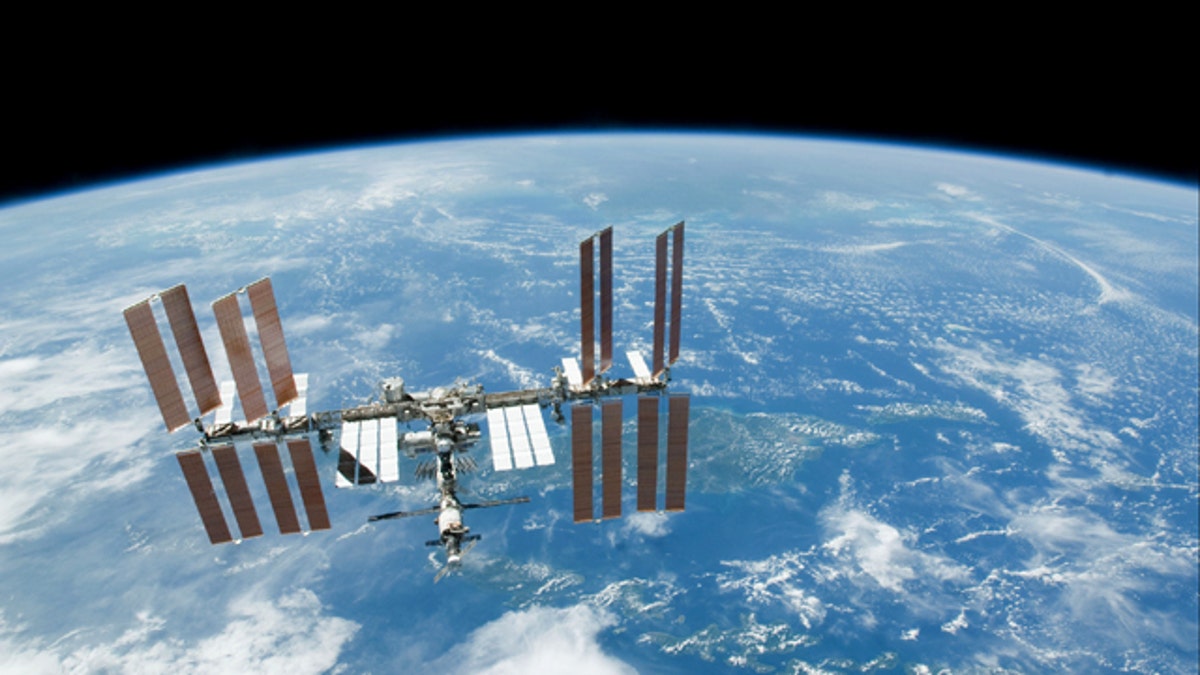
FILE - This Feb. 19. 2010 file photo provided by NASA shows the International Space Station with Earth's horizon as a backdrop. Several power systems have been shut down aboard the International Space Station after a cooling system malfunctioned. NASA says in a posting on its website that one of two cooling loops aboard the space station was shut down Saturday, July 31, 2010. A module that pumps ammonia coolant to prevent equipment from overheating was still shut down early Sunday, Aug. 1. (AP Photo/NASA, File) (AP Photo/NASA, File)
CAPE CANAVERAL, Fla. – A pair of spacewalking cosmonauts installed a new telescope mount on the International Space Station on Thursday despite a flaw in the device.
Russians Fyodor Yurchikhin and Aleksandr Misurkin -- making their second spacewalk in under a week -- initially were told to give up trying to plug in the 6-foot platform for a yet-to-be-launched telescope.
But after more than an hour of discussion at Russian Mission Control outside Moscow, the decision was reversed and the cosmonauts installed it.
Yurchikhin and Misurkin reported that the base of the platform appeared to be misaligned because it wasn't assembled properly on the ground. The problem could prevent the future telescope from pointing in the right direction.
"We cannot spend a lot of time here," one of the cosmonauts complained as they struggled with the equipment.
- Loch Ness monster-like reptile returns to NY
- 5 great uses for pee (thank you, Smithsonian)
- 2,700-year-old Hebrew inscription discovered in biblical city
- Astronaut recounts near-drowning on spacewalk, says he felt all alone, felt like eternity
- Online access ‘a human right,’ Facebook CEO Mark Zuckerberg says
They hauled the platform back to the hatch and went to work inspecting antenna covers; one of the protective shields came loose Monday and floated off.
But engineers determined the 90-degree misalignment could be overcome at a later date. So the cosmonauts lugged the telescope platform back to the work site and secured it.
They had removed a laser communication experiment from that spot earlier, even though it was tough working in that location.
"Tight quarters up here as far as anything to grab onto," one of the cosmonauts commented in Russian. "You got that right," replied the other. (The English translation does not identify the speakers.)
The spacewalkers also unfurled and waved a Russian flag that they took out in honor of Russia's Flag Day. "Now we can see the flag of our Motherland," one of the cosmonauts said in an impromptu speech.
Earlier, the cosmonauts ran into some difficulty tightening the antenna covers.
Because of the flyaway cover, the cosmonauts double-checked the remaining protective shields to make sure they were secure. At least two were loose, one by a lot. NASA said the lost cover posed no risk to the 260-mile-high outpost.
NASA, meanwhile, has suspended all U.S. spacewalks while the investigation into last month's near-drowning continues. An Italian astronaut's helmet filled with water during a spacewalk on July 16. He barely made it back inside. The water is believed to have originated from the suit's cooling system.
The spacesuits used by the Russians are different.
The two cosmonauts had smoother sailing during last Friday's spacewalk, performing cable hookups for a new Russian lab that is supposed to lift off from Kazakhstan sometime next year. The launch had been targeted for December, but recently was delayed until at least spring.
Several times during Thursday's six-hour spacewalk, the radio lines screeched so loudly that the cosmonauts' voices could not be heard by Russian Mission Control. "We should be wearing ear plugs here," someone commented in Russian.
Before returning inside, the crew gathered samples from the surface of a hatch for eventual analysis on Earth. There is evidence, a NASA commentator said, of possible biological growth surviving in the harsh environment of space.
"I think the windows are clean. We should wrap it up. What do you think?" Misurkin said.
This was the 173rd spacewalk at the space station, coming up on the 15th anniversary of the launch of its first part. The four other space station residents -- two Americans, one Italian and another Russian -- kept tabs on the spacewalk from inside.
The swiveling platform will hold an optical telescope that will be launched in November and installed by spacewalking cosmonauts a month later.
As for the defective spacesuit of Italian astronaut Luca Parmitano, NASA said it will return part or all of the outfit early next year on a commercial SpaceX capsule. That will be the first opportunity to get cargo back on Earth. The three-person Russian Soyuz spacecraft used to ferry astronauts are too small for big extra pieces, and the Russian supply ships burn up upon re-entry, doubling as trash cans.
